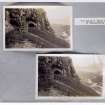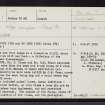Pricing Change
New pricing for orders of material from this site will come into place shortly. Charges for supply of digital images, digitisation on demand, prints and licensing will be altered.
Creag Nan Uamh
Cave(S) (Prehistoric), Human Remains (Neolithic), Animal Remains (Palaeolithic), Awl (Bone)(Medieval), Pin (Ivory)(Medieval)
Site Name Creag Nan Uamh
Classification Cave(S) (Prehistoric), Human Remains (Neolithic), Animal Remains (Palaeolithic), Awl (Bone)(Medieval), Pin (Ivory)(Medieval)
Alternative Name(s) Allt Nan Uamh; Inchnadamph Caves; 'reindeer Cave'; 'bone Caves', Uamh An Claonaite
Canmore ID 4615
Site Number NC21NE 1
NGR NC 2679 1704
NGR Description NC 26791704 and 26801702
Datum OSGB36 - NGR
Permalink http://canmore.org.uk/site/4615
- Council Highland
- Parish Assynt
- Former Region Highland
- Former District Sutherland
- Former County Sutherland
NC21NE 1 2679 1704 to 2680 1702.
(NC 2679 1704 and NC 2680 1702) Caves (NAT) (Two shown)
OS 6"map, Sutherland, 1st ed., (1878)
There are four caves in a limestone cliff, about 200 ft. above Allt nan Uamh - a tributary of the Loanan, near Inchnadamph.
In 1889, Dr J Horne and Dr B N Peach explored the third cave from the west and found bones of a rich Arctic fauna with traces of human habitation (Proc Roy Soc Edinburgh 1927)
Further excavations were made in 1926 by J E Cree, caves 1 and 2 from the west being dug and a trial trench dug in the 1889 cave.
Finds included animal bones, human skeletons - one a definite burial, an iron blade a bone pin and an awl, a reindeer horn implement, cut and scratched antler and charcoal. The nature of the fauna, state of fossilation of the bones, and the geological evidence suggests an Upper Palaeolithic date, certainly belonging to Magdalenian or earlier.
Proc Roy Soc Edinburgh 1917; J G Callander, H E Cree and J Ritchie 1927.
Refers to the late Upper Palaeolithic date suggested for the occupation of the caves. The animal remains apparently represent a late arctic fauna surviving in a refuge area into early post glacial times. It suggests that the human habitation was not earlier than Mesolithic or even Neolithic in date.
A D Lacaille 1954.
The material from Allt nan Uamh is at the Royal Scottish Museum, Chambers St., Edinburgh.
Information contained in letter from A S Henshall, (Asst. Keeper, NMAS) 28 December 1961.
The most easterly cave is very shallow and little more than a rock shelter, the other three are true caves and have narrow tunnels leading off them.
Visited by OS (G H P) 6 June 1962.
No change to previous field report.
Visited by OS (J M) 11 July 1980.
Samples were taken for radiocarbon dating from bone awl and double ring headed pin of walrus ivory, found in "cave earth" during the excavation of reindeer Cave by J Cree in 1926. the bone awl had too little collagen to be datable.
Walrus ivory pin NMS HM 377 1900+/-80bp (50+/-80ad) OxA-3527
NMRS MS/735/1.
Excavations in the 1920's at the Creag nan Uamh bone caves, near Inchnadamph, aroused considerable interest in the possibility of evidence for a Palaeolithic presence in north-west Scotland. Four objects found during those excavations, including the one on which the principal claim for a Palaeolithic date was based, are published here for the first time. Two are probable Viking Age/early medieval artefacts of unusual type, one is undated but is possibly also of the same period, and the fourth, while almost certainly of Pleistocene age, is regarded as an unmodified natural object. Collectively these items serve to discount previous claims for Palaeolithic human presence. Radiocarbon dating of the human skeletal remains found, however, suggests the caves were a burial place in the Neolithic period. This paper makes extensive use of archive domumentation to put the 1920s discoveries at Crea nan Uamh and their aftermath into historical context.
Proc Soc Antiq Scot 2005; A Saville.
Field Visit (9 June 1909)
Caves, Inchnadamph. About 1 m. up the Allt nan Uamh, a tributary of the River Loanan, which flows into Loch Assynt at its upper end, are a series of caves in a limestone cliff some 200' above the level of the stream on the S. Evidences of human occupation were found in one of these which was excavated, about 2' below the surface ; and from 3' to 4' in depth there was also found, among other osseous fragments, a finely preserved canine tooth of the brown bear.
See Trans. Inv. Scient. Soc., iv. p. 118.
OS 6-inch map: Sutherland Sheet lxxxii.
RCAHMS 1911, visited (AOC) 9th June 1909.
Excavation (22 June 2008 - 15 October 2008)
NC 2680 1702 The bones of an adult brown bear and an ulna from a second bear were recovered from a dry high level passage in cave system, 22 June–15 October 2008. The remains, which were originally discovered in May 1995 by cave divers from the Grampian Speleological Group, were considered to be under threat when a new dry entrance, providing easier access to the site, was discovered in January 2008. The remains were in the area covered by the Creag nan Uamh Caves scheduled monument (Index 606) and the Ben More Assynt SSSI.
After surveying the passages containing the bear remains, which also included important cave morphology features, a limited excavation was conducted and was successful in removing around 80% of the bones from one bear and the ulna from a second bear; the latter relating to a different depositional event. The bones are now awaiting radiocarbon dating and detailed analysis, which will be crucial in determining how the animals or their remains entered the cave system. It is anticipated that the bears died at least 12,000 years ago.
Report: Highland SMR, Historic Scotland, RCAHMS and Scottish Natural Heritage
Funder: Grampian Speleological Group and National Museums Scotland
Steven Birch (Grampian Speleological Group, Edinburgh), 2008
Excavation (16 May 2009 - 31 October 2009)
NC 2680 1702 In 2008 (DES 2008, 98) most of the skeleton of a brown bear was removed from the Portobello Promenade passage (NC 2688 1690) and an ulna was recovered from Legless Highway (NC 2688 1695). Further visits were made to both of these sites 16 May–31 October 2009.
A detailed examination of the first site unearthed some small rib fragments and a metacarpal, while a vertebra and rib fragments were found lying exposed near the second. The main finds were the result of a caver spotting a reindeer antler protruding from sediments in what is now named Antler Chamber (NC 2682 1700). This chamber lies directly under the Bone Caves, though any connecting passage has been choked, possibly for many thousands of years. While assessing the work several more finds were made including a bear humerus lying on the surface, a wild horse lower mandible, and more reindeer antler fragments and a rib
protruding from the floor sediments. The prize find was a superb, almost completely undamaged, brown bear skull, hidden behind a slab next to the chamber wall. Permission was sought and granted by Historic Scotland and all finds were collected and taken to NMS for conservation.
The bear skeleton recovered in 2008 has been radiocarbon dated at 23,650 ± 110 BP, making this the first Scottish Pleistocene brown bear. A month later the isolated bear ulna was found to be much older at 45,000 ± 1000 BP, Three finds from Antler Chamber were dated: a reindeer antler at 12,110 ± 40 BP; a bear humerus at 11,625 ± 40 BP; and a wild horse mandible at 11,595 ± 40 BP. These dates will help to refine the chronology of the Late Devensian ice sheet in Assynt, as brown bear would not be present during full glacial conditions and the cave entrances would not have been accessible. We gratefully acknowledge Scottish Natural Heritage’s assistance in funding the radiocarbon dates for this project.
Archive: Sealladh Alainn, 4 Upper Breakish, Isle of Skye, Invernessshire, IV42 8PY – Data Structure Report: Highland Council SMR, Historic Scotland, RCAHMS and SNH (intended)
Funder: Grampian Speleological Group, NMS and SNH
Steven Birch and Ivan Young – Grampian Speleological Group, Edinburgh
























